The Italdesign Zerouno marks a wild turning point in automotive history—a moment when one of the world’s most influential design houses decided, “Hey, let’s build our own supercar.” Bold, right? Italdesign needed to show off its chops as an independent engineering force after decades of ghost-designing for other brands, so the Zerouno became their high-speed business card.
This $1.69 million hypercar rolled out of the same studios that once birthed the original Volkswagen Golf, BMW M1, and Lotus Esprit. That’s a pedigree you can’t fake.
Only five Zerounos ever hit the road. This Audi R8-based machine is now one of the rarest modern supercars you’ll ever see—or probably never see, honestly.
Italdesign used the Zerouno to announce their transformation from a classic carrozzeria into a full-blown automotive development powerhouse. Formula 1-inspired aerodynamics, a naturally aspirated V10, and a design that just screams “look at me”—they built every piece to prove they could hang with the supercar legends.
The Zerouno’s story isn’t just another exotic car launch. It’s about how Giorgetto Giugiaro’s company took on the modern era, tackled the insane technical hurdles of building a road-legal hypercar in just 14 months, and entered the ultra-exclusive world of limited-run collectibles where every stitch and seam matters to obsessive collectors.
Backstory and Concept Development
The Italdesign Zerouno came to life when a legendary design house finally decided to jump into the supercar ring. After decades of automotive expertise, they wanted to show the world what they could do on their own terms.
Origins and Company Heritage
Giorgetto Giugiaro kicked off Italdesign in 1968 in Moncalieri, just outside Turin. The company quickly became a go-to carrozzeria, shaping icons for big automakers all over the globe.
For years, Italdesign stayed in the background, sketching and engineering for other brands without ever sticking their own name on a car. They handled everything from napkin doodles to full-blown production plans.
By 2017, Volkswagen Group acquired a majority stake in Italdesign Giugiaro S.p.A. in 2010. By 2017, they were already well integrated, and the Zerouno project was a direct result of that stronger partnership and expanded capabilities
Building their own supercar was a huge leap. They wanted to prove they could do it all, not just design pretty shapes.
Motivation and Inspiration for Creation
The Zerouno started with a gutsy goal: show everyone they could build a supercar from scratch. The leadership team was itching to prove they weren’t just another design consultancy.
Lightweight construction was the heart of the project. Engineers and designers locked onto that idea from the first sketch.
They used simultaneous engineering—so design and engineering teams worked side by side, right from the start. Italdesign had been fine-tuning this approach since the late ‘60s, and by now, they had it down to an art.
Management saw a chance to create something that would turn heads and drop jaws. They wanted a car that showed off every ounce of their technical and creative muscle.
Debut at Geneva Motor Show and Public Reception
The Zerouno made its grand entrance at the 2017 Geneva International Motor Show. That’s about as high-profile as it gets for a first production car.
The car turned a lot of heads. Its aggressive looks and minuscule production run made it a magnet for attention. Only five units—blink and you’ll miss them.
The first Zerouno sold under the Italdesign Automobili Speciali banner. This new division took the wheel for direct sales.
Journalists immediately picked up on the car’s importance. They saw it as Italdesign’s leap from design studio to full-fledged supercar builder.
Behind-the-Scenes Stories
The project really showcased Italdesign’s unusual approach. Their Styling Centre and Engineering Development teams basically became one big creative hive.
All five Zerounos sold out before production wrapped up. That’s a pretty loud “mission accomplished” for their first go.
The second Zerouno popped up at Pebble Beach Concours d’Elegance in California, wearing a wild metallic red. It proved just how bespoke these cars could get for lucky buyers.
Getting each car type-approved meant design and engineering had to work in lockstep. With only five cars, every single one was basically a hand-built, one-off masterpiece.
Design, Engineering, and Technical Features
The Zerouno puts Italdesign’s simultaneous engineering on full display. They mixed sharp aerodynamic lines with featherweight construction and some seriously advanced materials. Under leaders like Filippo Perini, the Moncalieri team showed they could do it all.
Exterior Styling and Aerodynamic Innovations
The Zerouno’s looks follow a “lightweight first” mantra, shaping every curve and vent. Filippo Perini led the design crew, bringing swagger from his Lamborghini days.
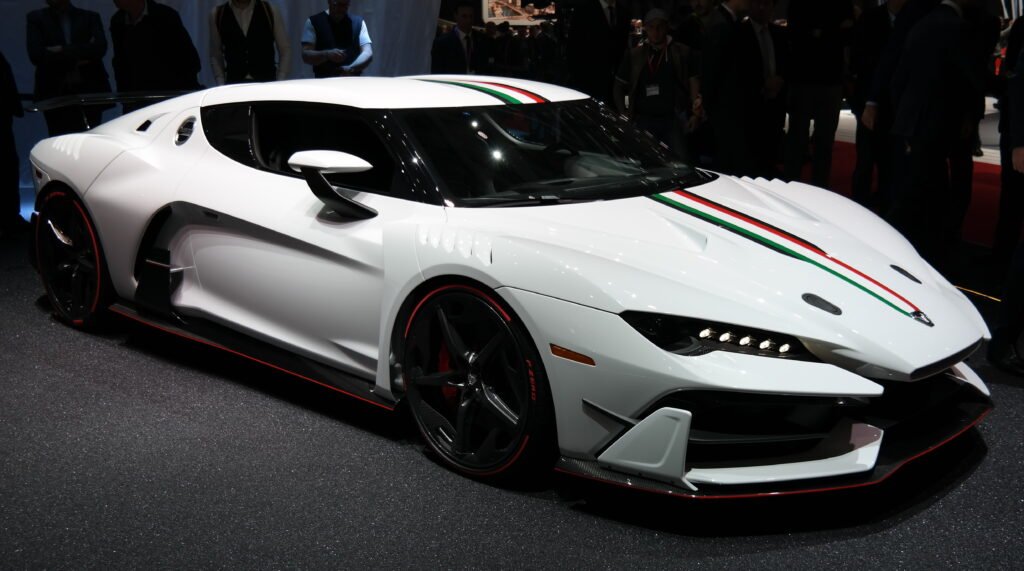
Up front, there’s a snout with an integrated “Ypsilon” duct—equal parts eye-candy and wind-tunnel wizardry. It channels air and boosts downforce, so it’s not just for show.
Key Aerodynamic Features:
- Front splitter with built-in air channels
- Side intakes to keep that V10 cool
- Rear diffuser with exposed wheel sections
- Optional rear wing (if the buyer wanted a little extra flair)
At the back, you get “aerodynamic origami”—crazy surface cuts that leave parts of the 305/30 ZR Pirelli tires in plain view. It’s a cheeky nod to old-school Le Mans racers.
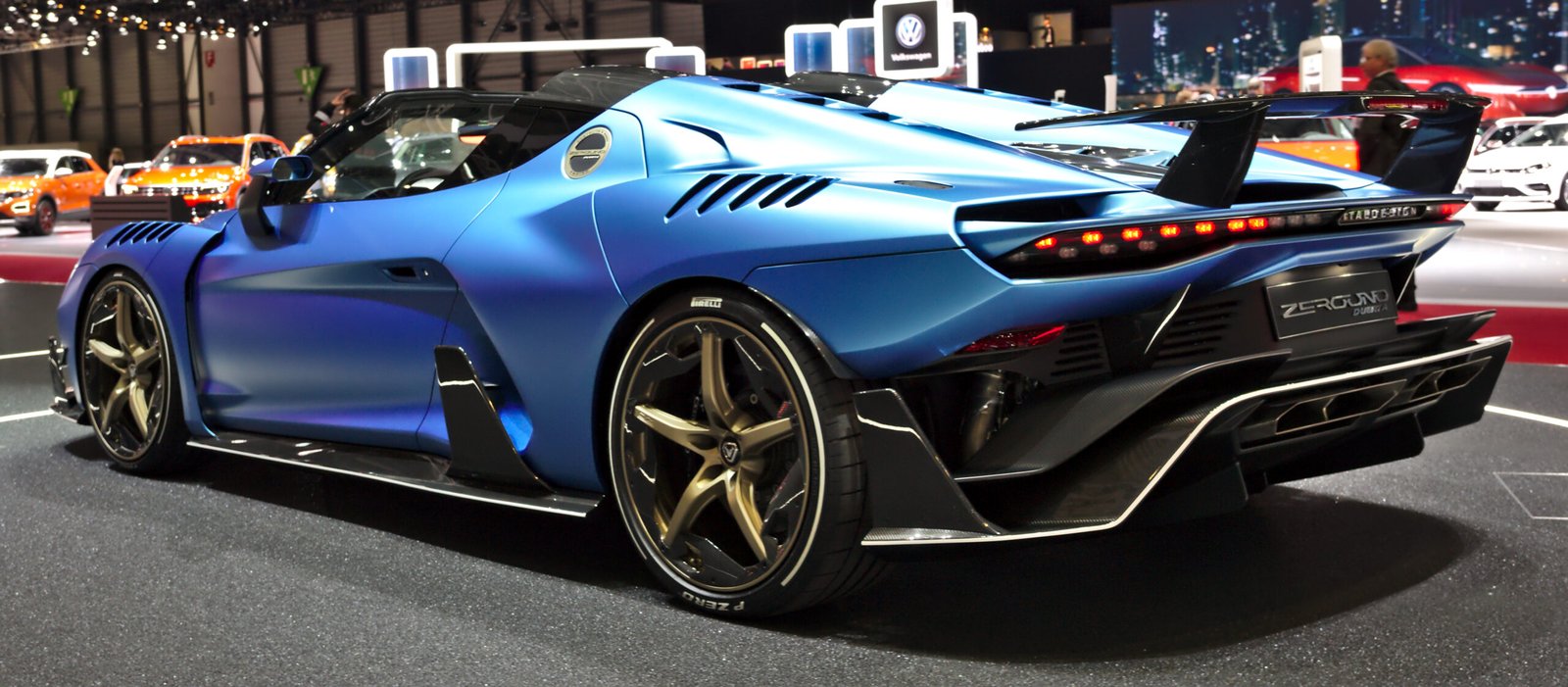
The entire rear clamshell lifts off in one piece, just like Group C prototypes. It’s dramatic, practical, and somehow still solid as a rock.
Lastly, let’s not forget Zerouno’s incredible exhaust sound
Chassis, Materials, and Simultaneous Engineering
The team went all-in on simultaneous engineering, a method they’d been perfecting since the late ‘60s. Instead of waiting for one department to finish before the next started, everyone jumped in together from day one.
The Zerouno rides on Audi’s modular aluminum chassis—the same bones as the R8 and Lamborghini Huracán. This shortcut let them tap proven performance and shave off precious development time (and headaches).
Technical Specifications:
- Chassis: Modular aluminum space frame
- Body: Carbon fiber everywhere
- Weight: Kept low thanks to all that carbon
- Stance: Sits 40mm lower than an Audi R8
Carbon fiber dominates the body panels, letting them craft wild shapes and keep things light. Inside, you’ll spot carbon weave everywhere, both for looks and structure.
Antonio Casu, their Chief Technical Officer, ran the engineering show. The team logged 40,000 kilometers at Nardo and other tracks—no shortcuts, just pure testing grind.
Interior Craftsmanship and Driver-Centric Elements
Inside, it’s carbon fiber heaven, splashed with yellow and blue graphics as a nod to Turin. The main display even shows off custom graphics, including a slick rendering of the car itself.
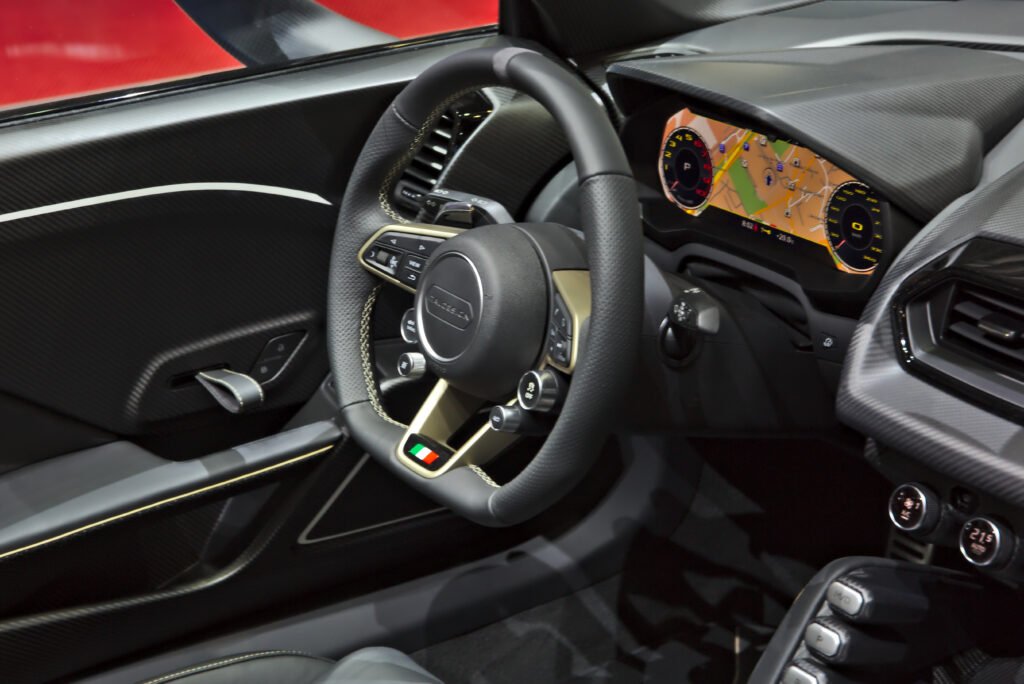
Everything inside screams racing. The seats hug you tight for hard driving, but they’re still comfy enough for a road trip. Carbon fiber covers the dash and pops up everywhere you look.
Interior Features:
- Custom digital display graphics
- Carbon fiber dash and trim
- Seats built for performance
- Colors inspired by Turin’s flag
The steering wheel and controls focus on the driver, not pampering. If you want plush, look elsewhere—this car’s about the experience, not the amenities.
The cabin strikes a balance: race car vibes, but still usable on the street. Every button and surface amps up the drama and keeps you in the moment.
Designer and Engineering Team Profiles
Filippo Perini led the styling charge, having already penned legends like the Alfa Romeo Nuvola and 8C Competizione back at Lamborghini.
Giorgetto Giugiaro started Italdesign half a century earlier with Aldo Mantovani. Their influence still shaped the Zerouno’s “let’s do it all at once” approach.
Jörg Astalosch was CEO at the time, pushing Italdesign to expand beyond just VW Group collaborations. His drive helped turn the Zerouno into a showpiece for everything the company could do.
Le Mans champ Dindo Capello joined the engineering squad. His racing know-how helped fine-tune the car’s dynamics and validate its aerodynamics.
The whole team worked out of Italdesign’s Moncalieri HQ, right in the heart of Italy’s car-building country. That location kept them close to tradition but always looking forward.
Performance and Model Variants
The Zerouno doesn’t mess around—it’s got a Lamborghini-sourced V10 that rockets it from 0-60 mph in just 3.2 seconds, topping out at 205 mph. Italdesign even dropped an open-top Duerta version, keeping the same guts but adding a dose of exclusivity.
Engine Specifications and Capabilities
The Zerouno packs a 5.2-liter V10 straight from Lamborghini. It cranks out 610 horsepower and pairs up with a seven-speed dual-clutch transmission—no turbo, just pure, naturally aspirated muscle.
The engine shares a lot with the Audi R8 and other VW Group supercars. That VW connection let Italdesign focus on wild styling and aero while trusting the mechanicals to deliver.
Key Engine Specifications:
- Displacement: 5.2 liters
- Configuration: V10, naturally aspirated
- Power Output: 610 HP
- Transmission: 7-speed dual-clutch automatic
With all that carbon fiber, the Zerouno stays light and sharp. The mid-engine layout puts weight right where it needs to be for track attacks. It’s an unapologetic, old-school supercar—just the way some of us like it.
On-Road and Track Performance
The Zerouno rockets from 0-60 mph in just 3.2 seconds. Top speed? A wild 205 mph, right up there with the fastest supercars around.
Its aerodynamic body isn’t just for show. Those Y-shaped hood vents and rear spoiler wings crank out serious downforce, while the six-sided front intake and side scoops hustle air exactly where it needs to go.
Performance Figures:
- 0-60 mph: 3.2 seconds
- Top Speed: 205 mph
- Construction: Carbon fiber body
- Aerodynamics: Active downforce generation
On the track, the carbon fiber build and clever aero give it a featherweight feel. It hugs corners with confidence and seems more obsessed with stability than just blasting in a straight line.
Special Editions: Zerouno Duerta and Facelifts
The Zerouno Duerta broke cover at the 2018 Geneva International Motor Show as the open-top flavor. It keeps all the mechanical goodies but ditches the fixed roof for a little more sky.
Only five Duertas exist—same as the coupe, so exclusivity stays sky-high. The sticker price? Even steeper than the standard model’s $1.7 million starting line.
Both versions share the same engine and carbon fiber magic. The Duerta had to bulk up structurally to stay stiff without a roof overhead.
The base Zerouno starts at $1.7 million, but with options, it can climb above $2 million. All five coupes vanished instantly after the announcement—collectors just couldn’t resist.
Ownership, Reviews, and Cultural Impact
The Zerouno really marked a turning point for Italdesign. They went from design consultants to supercar builders, and the buzz from journalists and collectors was intense.
With only five cars made, owning one became the ultimate flex for anyone chasing extreme rarity in the supercar scene.
Driving Experience and Media Test Drives
Journalists described the Zerouno as both approachable and aggressive. It sits a full 40mm lower than the Audi R8 and honestly, it feels way more alive than its platform cousin.
Test drivers loved the reworked suspension and dampers, which add an extra punch. The seven-speed box snaps through gears faster than the standard R8 could ever dream of.
Reviews often called out its stability and surprisingly friendly manners. Not many supercars put drivers at ease like the Zerouno does—maybe that’s part of its magic.
The 5.2-liter V10 (yep, straight from the R8 and Huracán) brings that familiar, addictive roar. All-wheel drive keeps things predictable whether you’re on a twisty road or a slick track.
Owner Demographics and Enthusiast Community
The Zerouno mostly attracted ultra-wealthy collectors who wanted something nobody else could have. All five cars sold for €1.5 million each before a single one rolled off the line.
These buyers didn’t just want a car—they wanted rolling art, a piece of design history. Rarity and heritage? That’s the real draw here.
With so few cars, there’s no real “owner’s club.” Instead, each Zerouno lives as a solo act in a collector’s garage, occasionally popping up in the broader supercar world.
Italdesign’s legacy—think BMW M1 and Volkswagen Golf—pulled in buyers who care about the history behind the badge. Giugiaro’s name on the project only sweetened the deal.
Competitors in the Segment
The Zerouno squares off against the rarest of the rare—other coachbuilt supercars and ultra-limited runs from the big names.
Key competitors include:
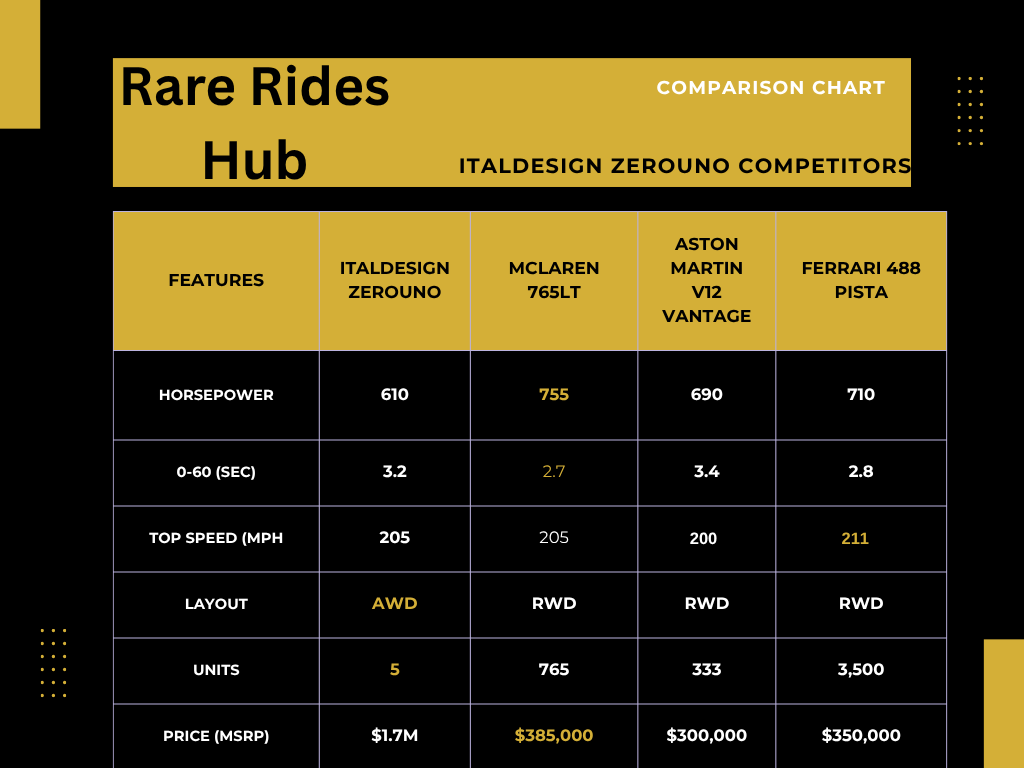
Italdesign’s collaboration with Nissan on the GT-R50 project showed they could play outside the Volkswagen sandbox. That partnership opened new doors.
They’ve also teamed up with Audi and Airbus for the Pop.Up Next concept, dreaming up wild ideas for the future. And their work with Vinfast proves they’re thinking globally now.
Notable Quotes on Design and Reception
Design chief Filippo Perini summed up the mission: “We wanted to do a limited-series car, to create a demonstrator of the capability we have in the company.”
Perini also admitted, “The truth is, it’s not well enough known outside. We sold the five units at the price we set, and this attracted different OEMs beyond the VW group.”
One Italdesign engineer described the design ethos:“We wanted it to be nude, like an old Le Mans car,” referencing the exposed rear section.
CEO Jörg Astalosch sees the Zerouno as a springboard for bigger things. He wants half of Italdesign’s business to come from clients outside the VW Group.
Journalists keep pointing out how the Zerouno breathes new life into Italian coachbuilding. It’s a throwback to the glory days of custom supercars, with a modern twist.
Legacy, Market Value, and Brand Influence
The Italdesign Zerouno really flipped the script for the company. They went from design house to actual supercar maker, and collectors jumped at the chance to own a piece of that story.
Impact on Italdesign’s Brand and Coachbuilding Revival
The Zerouno marked Italdesign’s bold leap back into manufacturing after decades of designing for others. It brought back their coachbuilding roots and proved they could be more than just a design studio.
With VW Group backing, they finally had the resources and swagger to make it happen. The Zerouno became a rolling showcase for their engineering chops, not just their sketchbooks.
They managed to balance old-school design DNA with new-school performance. It’s kind of inspiring, honestly, seeing a legacy brand stay true to itself while charging into the future.
Key Brand Impact:
- Put Italdesign on the map as a boutique supercar builder
- Drew in high-net-worth clients
- Opened up fresh revenue streams outside consulting
- Deepened their ties with VW Group’s performance arm
Awards, Records, and Recognitions
The Zerouno’s not a race winner, but it’s scooped up plenty of praise for design and engineering brilliance. Industry folks love how it balances wild looks with real-world function.
Notable Recognitions:
- Starred in top automotive design exhibitions
- Took the spotlight at major car shows
- Won over journalists with its performance and design
- Earned props for its carbon fiber innovation
Sure, it never had a shot at mainstream racing glory with such tiny numbers. But among supercar fans, its track focus and aero wizardry earned solid respect.
Media coverage keeps circling back to how the Zerouno revived the boutique Italian supercar scene. It’s proof that small-scale, high-craft production can still shake up the industry.
Price Trends and Collector Interest
The Zerouno hit the market with a jaw-dropping price tag—about €1.5 million. That alone put it in the kind of club where most of us just press our faces to the glass.
With only five cars ever built, scarcity isn’t just a buzzword here—it’s the whole story.
Price Factors:
- Extreme rarity: Only 5 examples produced
- Brand significance: Italdesign’s first modern supercar
- Engineering excellence: Advanced carbon fiber construction
- Historical importance: Marked company’s manufacturing return
Prices haven’t really dropped since the last car rolled out; if anything, they’ve crept up. Collectors see the Zerouno as more than just a car—it’s a turning point in design, a real feather in the cap for automotive history.
Wealthy buyers who chase after rare, meaningful cars keep their eyes peeled for a Zerouno. The Italdesign name alone brings a certain magic, like owning a piece of rolling art rather than just another fast machine.
Finding one for sale is like spotting a unicorn—secondary market listings almost never pop up. When one does, you’d better believe it commands a price that reflects its mythic status.
Final Words
All in all, Italdesign has made one of the boldest moves a design house can make, and by looking at numbers and demand, they for sure have made a great decision.
Italdesign’s move has pushed their popularity and capability beyond measure, and alongside it made one of the most beautiful cars to ever hit the road.
Thanks for reading! If you enjoyed this deep dive, be sure to subscribe to my email list for exclusive car reviews, insider tips, and weekly special offers on car parts, auctions, and gear — perfect for any car enthusiast.
If you have any thoughts or experiences with this car? Leave a comment below — I love hearing your opinions and sparking conversations with fellow enthusiasts.
And don’t forget to read related posts for more great content!

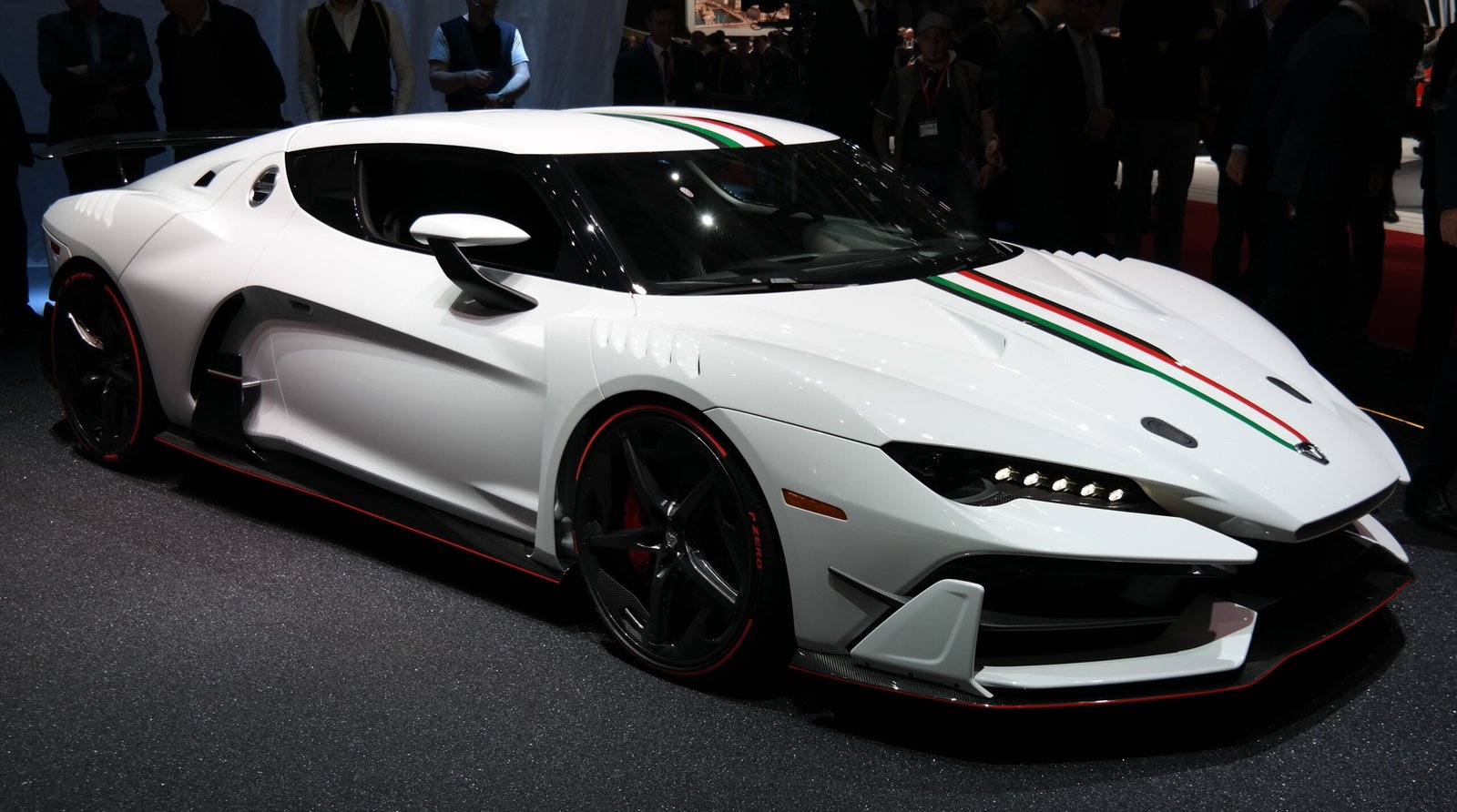

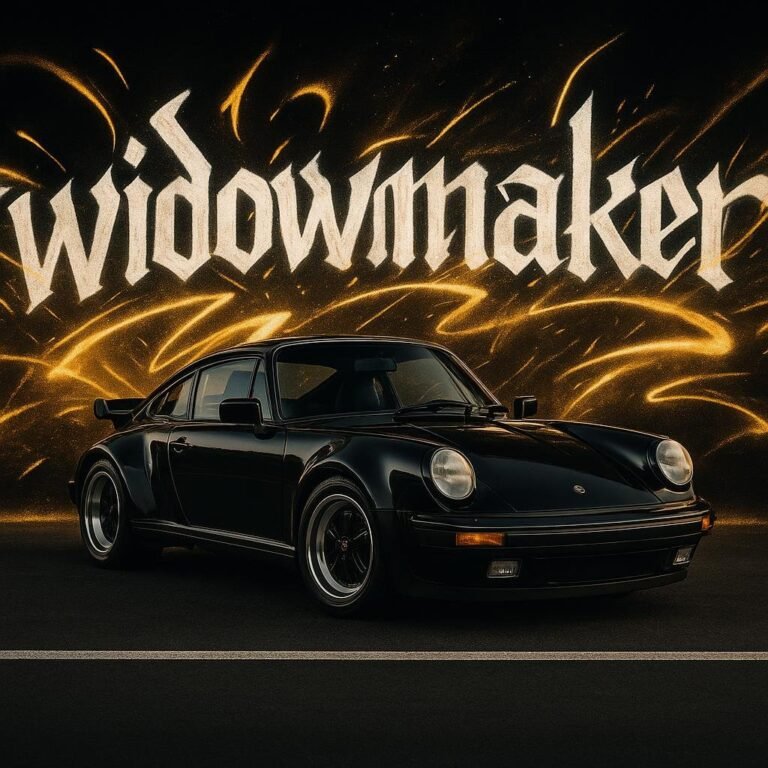
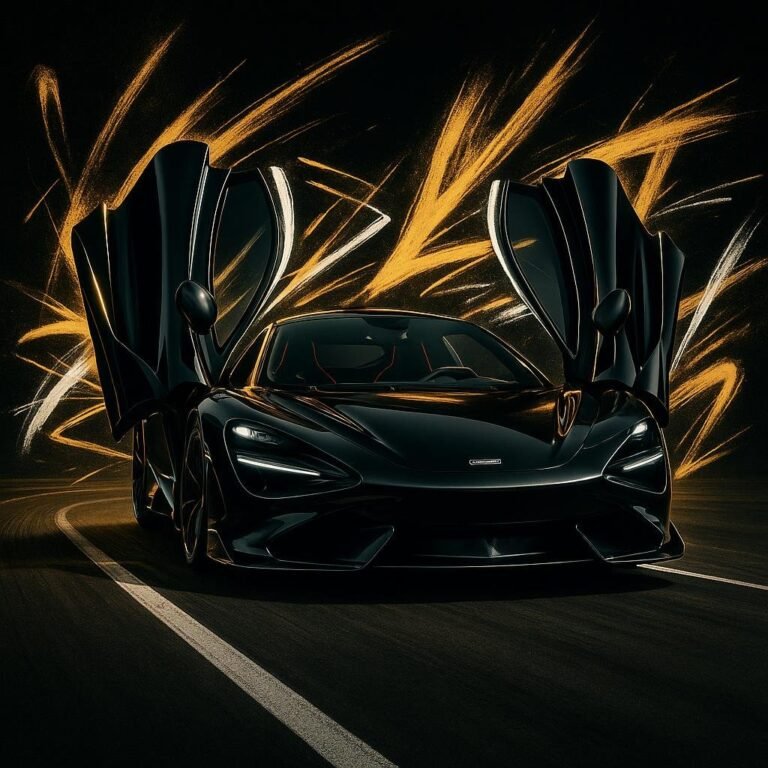
[…] two road-legal GT-Ones exist. That makes it absurdly rare among forgotten ’90s […]
[…] car buyers just assume their rides will lose value over time. But limited edition cars? They love to break that rule—sometimes in ways nobody […]